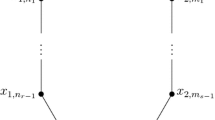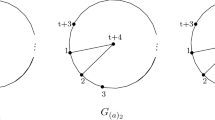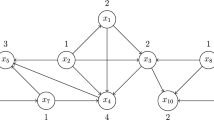Abstract
Let G be a simple finite graph. A famous theorem of Dirac says that G is chordal if and only if G admits a perfect elimination order. It is known by Fröberg that the edge ideal I(G) of G has a linear resolution if and only if the complementary graph \(G^c\) of G is chordal. In this article, we discuss some algebraic consequences of Dirac’s theorem in the theory of homological shift ideals of edge ideals. Recall that if I is a monomial ideal, \(HS _k(I)\) is the monomial ideal generated by the kth multigraded shifts of I. We prove that \(HS _1(I)\) has linear quotients, for any monomial ideal I with linear quotients generated in a single degree. For and edge ideal I(G) with linear quotients, it is not true that \(HS _k(I(G))\) has linear quotients for all \(k\ge 0\). On the other hand, if \(G^c\) is a proper interval graph or a forest, we prove that this is the case. Finally, we discuss a conjecture of Bandari, Bayati, and Herzog that predicts that if I is polymatroidal, \(HS _k(I)\) is polymatroidal too, for all \(k\ge 0\). We are able to prove that this conjecture holds for all polymatroidal ideals generated in degree two.
Similar content being viewed by others
Availability of Data and Materials
Not applicable.
References
Bandari, S., Rahmati-Asghar, R.: On the polymatroidal property of monomial ideals with a view towards orderings of minimal generators. Bull. Iran. Math. Soc. 45, 657–666 (2019)
Bayati, S., Jahani, I., Taghipour, N.: Linear quotients and multigraded shifts of Borel ideals. Bull. Aust. Math. Soc. 100(1), 48–57 (2019)
Crupi, M., Ficarra, A.: Very Well–Covered Graphs by Betti Splittings (2022). (preprint)
Dirac, G.A.: On rigid circuit graphs. Abh. Math. Sem. Univ. Hamburg 38, 71–76 (1961)
Ficarra, A.: Homological Shifts of Polymatroidal Ideals (2022). Available at arXiv preprint https://arxiv.org/abs/2205.04163[math.AC]
Ficarra, A.: HomologicalShiftsIdeals, Macaulay2 package (2022)
Francisco, C.A., Ha, H.T., Van Tuyl, A.: Splittings of monomial ideals. Proc. Am. Math. Soc. 137(10), 3271–3282 (2009)
Fröberg, R.: On Stanley-Reisner rings, Topics in algebra, Part 2 (Warsaw, 1988), 57–70, Banach Center Publ., 26, Part 2, PWN, Warsaw (1990)
Grayson, D. R., Stillman, M. E.: Macaulay2, a software system for research in algebraic geometry. Available at http://www.math.uiuc.edu/Macaulay2
Herzog, J., Hibi, T.: Monomial Ideals, Graduate Texts in Mathematics 260. Springer (2011)
Herzog, J., Moradi, S., Rahimbeigi, M., Zhu, G.: Some homological properties of borel type ideals (2021) (to appear in Comm. Algebra)
Herzog, J., Takayama, Y.: Resolutions by mapping cones. In: The Roos Festschrift volume Nr. 2(2), Homology, Homotopy and Applications 4, 277–294 (2002)
Herzog, J., Hibi, T.: Cohen–Macaulay polymatroidal ideals. Eur. J. Combin. 27(4), 513–517 (2006)
Herzog, J., Moradi, S., Rahimbeigi, M., Zhu, G.: Homological shift ideals. Collect. Math. 72, 157–174 (2021)
Jahan, A.S., Zheng, X.: Ideals with linear quotients, J. Combin. Theory Ser. A 117 (2010) 104–110. MR2557882 (2011d:13030)
Looges, P.J., Olariu, S.: Optimal greedy algorithms for indifference graphs. Comput. Math. Appl. 25, 15–25 (1993)
Bayati, S.: Multigraded shifts of matroidal ideals. Arch. Math., (Basel) 111(3), 239–246 (2018)
Funding
Not applicable.
Author information
Authors and Affiliations
Contributions
All authors have equally contributed to the paper.
Corresponding author
Ethics declarations
Conflict of Interest
Not applicable.
Ethical Approval
Not applicable.
Additional information
Publisher's Note
Springer Nature remains neutral with regard to jurisdictional claims in published maps and institutional affiliations.
Rights and permissions
Springer Nature or its licensor (e.g. a society or other partner) holds exclusive rights to this article under a publishing agreement with the author(s) or other rightsholder(s); author self-archiving of the accepted manuscript version of this article is solely governed by the terms of such publishing agreement and applicable law.
About this article
Cite this article
Ficarra, A., Herzog, J. Dirac’s Theorem and Multigraded Syzygies. Mediterr. J. Math. 20, 134 (2023). https://doi.org/10.1007/s00009-023-02348-8
Received:
Revised:
Accepted:
Published:
DOI: https://doi.org/10.1007/s00009-023-02348-8




